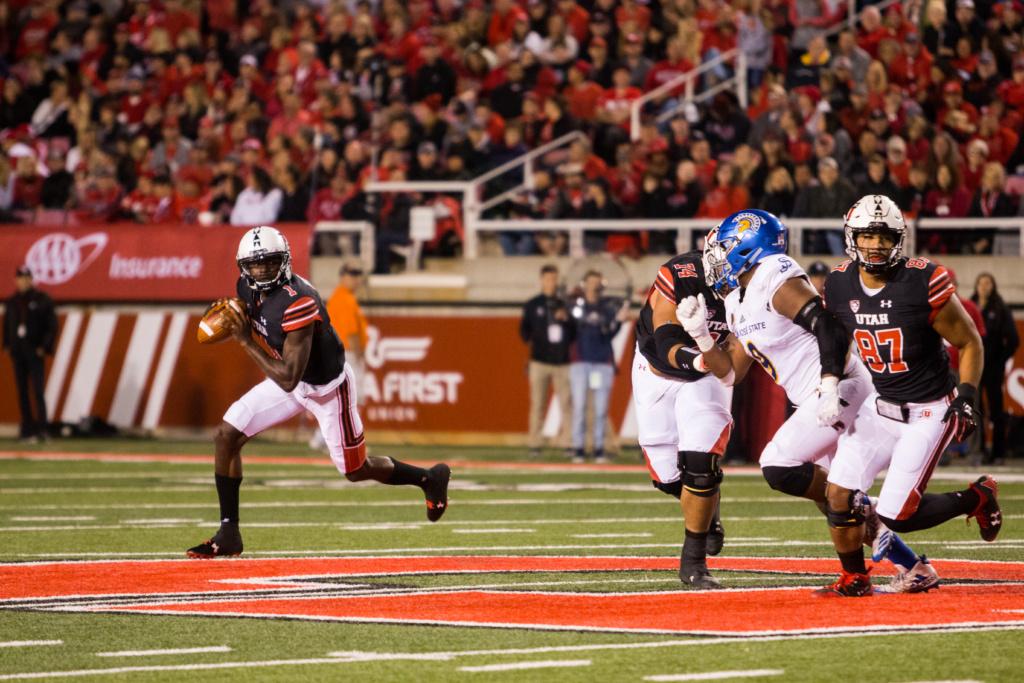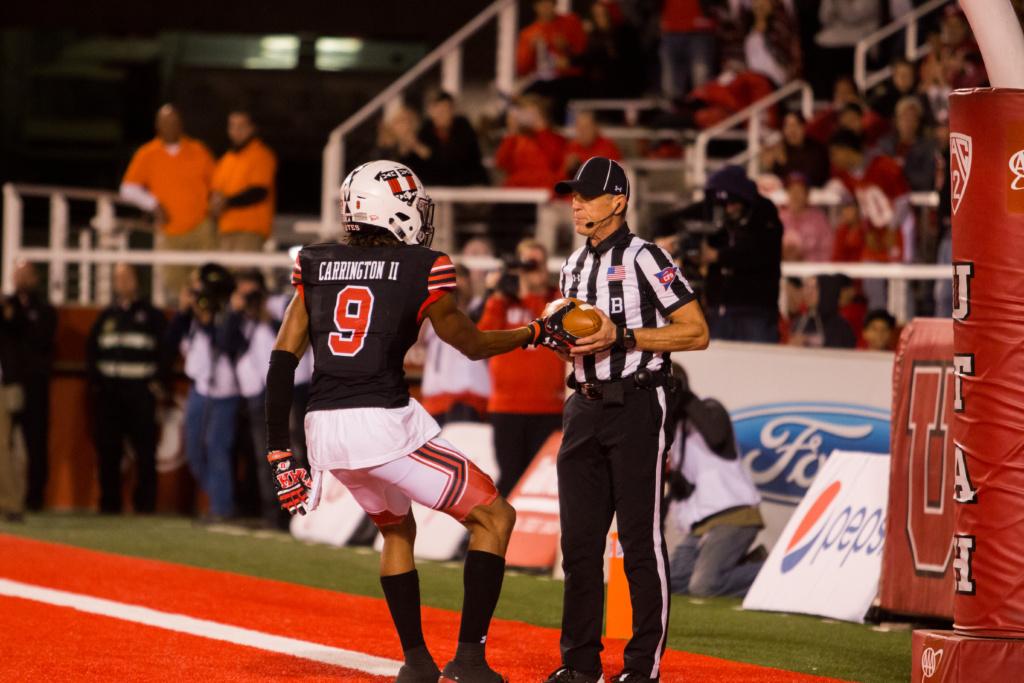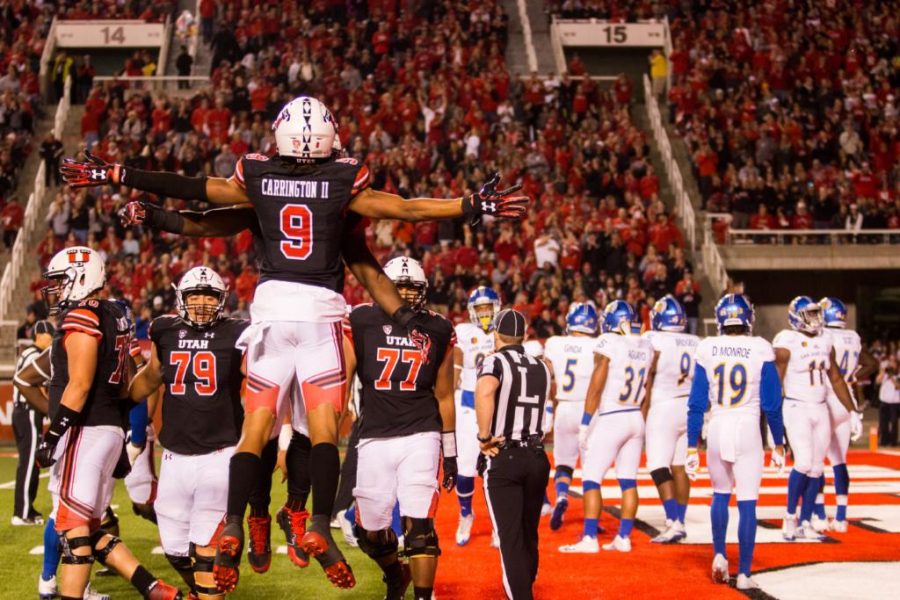It was a 54-16 victory for the University of Utah football team that defeated San Jose State to close out its nonconference schedule this past weekend. As Utah gears up to start conference play on Friday, Sept. 22, there are a handful of things to know before the Utes travel to Arizona.
The story of the season so far has been sophomore quarterback Tyler Huntley. It was a surprise to many when Huntley was named the starter over Troy Williams, a senior who started all 13 games for the Utes last year, but Huntley is proving that the Utah coaches made the right decision. The former Florida Gatorade Player of the Year has been poised and dynamic through his first three collegiate starts.

In fact, with 80 completions so far, Huntley has better numbers to start the season than any other Utah quarterback over the past 10 years. The next highest mark of 58 was reached by Brian Johnson, Terrance Cain and Jordan Wynn. He has also been extremely efficient. Despite attempting more throws through three games than any other Utah quarterback over the past 10 years, his 72 percent completion percentage is four points better than the next highest quarterback, and it’s 10 points better than the average completion percentage of all the Utah quarterbacks.
After Saturday night’s win, wide receiver Darren Carrington even compared Huntley to another quarterback that used to throw him the ball at the University of Oregon, former Heisman Trophy winner Marcus Mariota. While it may be unfair to make comparisons between a sophomore with three starts under his belt and a current NFL quarterback, looking at both quarterback’s first three starts shows that Carrington may be on to something.
Huntley’s first 3 starts – 80/111, 868 yards, 8 total TD’s
Mariota’s first 3 starts – 58/77, 674 yards, 8 total TD’s— Chrony Sports (@ChronySports) September 17, 2017
The stat lines actually compare pretty favorably. The higher volume for Huntley even suggests that he’s already more of a focal point in Utah’s offense than Mariota was for Oregon at the beginning of his career when he was tasked with simply distributing the ball accurately and efficiently to their playmakers. Only time will tell if Huntley can continue this kind of play against Pac-12 competition and turn into a possible Heisman candidate like Mariota.
The main beneficiary of Huntley’s play has been Carrington himself. He has caught nearly one-third of Huntley’s completions. He, along with UCLA’s Darren Andrews, is tied for second in the nation in receiving yards at 409 a piece. Carrington is the first Utah receiver since Dres Anderson to have three consecutive games of 100 receiving yards.

While this team has certainly shown the ability to move the ball down the field, their red zone effectiveness remains a concern. Many Utah drives have stalled in opponent territory, forcing Utah to settle for a field goal. Utah actually has as many field goals as they do touchdowns – 11. That amount of touchdowns are tied for the fewest touchdowns scored among Pac-12 teams. But the 11 field goals are by far the most by any Pac-12 program — no other team has more than six. Utah will have to find a way to kick fewer field goals and score more touchdowns if they want to keep pace with other teams in the league, many of whom have been scoring two, three or even four times as many touchdowns as field goals.
While the high number of field goals is in some ways an indictment of Utah’s offense, they at least have a kicker who can make them. The walk-on senior, Matt Gay, comes from Utah Valley University where he played soccer. Gay has arguably been the MVP of Utah’s first three games. Take his field goals away in the rivalry game and Utah would have lost to BYU 13-7. Against the Spartans, he kicked a 56-yard field goal, the second-longest field goal in Utah history, plus he had added a 50-yarder during the game. All in all, he’s 11-of-11 in field goals thus far, and he’s tied for the most in the nation.
Besides red zone efficiency, another concern through three games this season has been penalties. Utah had 11 in each of their first two games, many of which contributed to the aforementioned stalled drives. After the first two games, only three teams in the nation had more penalties than the Utes. They were able to get things cleaned up somewhat against San Jose State, finishing the night with six penalties called against them. If the 22 penalties in two games were just a symptom of working out the kinks of a new offense to start the season, they should be fine. If not, it could be the team’s Achilles heel.
For a long time, Utah fans have bemoaned the absence of a prolific offense to accompany their stingy defense, which has consistently been among the best in the nation. Many fall back on the excuse, “If only Utah had a good offense, it could be a real contender.” Between a new offensive coordinator that has resurrected the Utah passing game, a potential All-American talent at wide receiver and possibly the best Utah quarterback since Alex Smith, this may be the year things turn around.
@jusstadams


